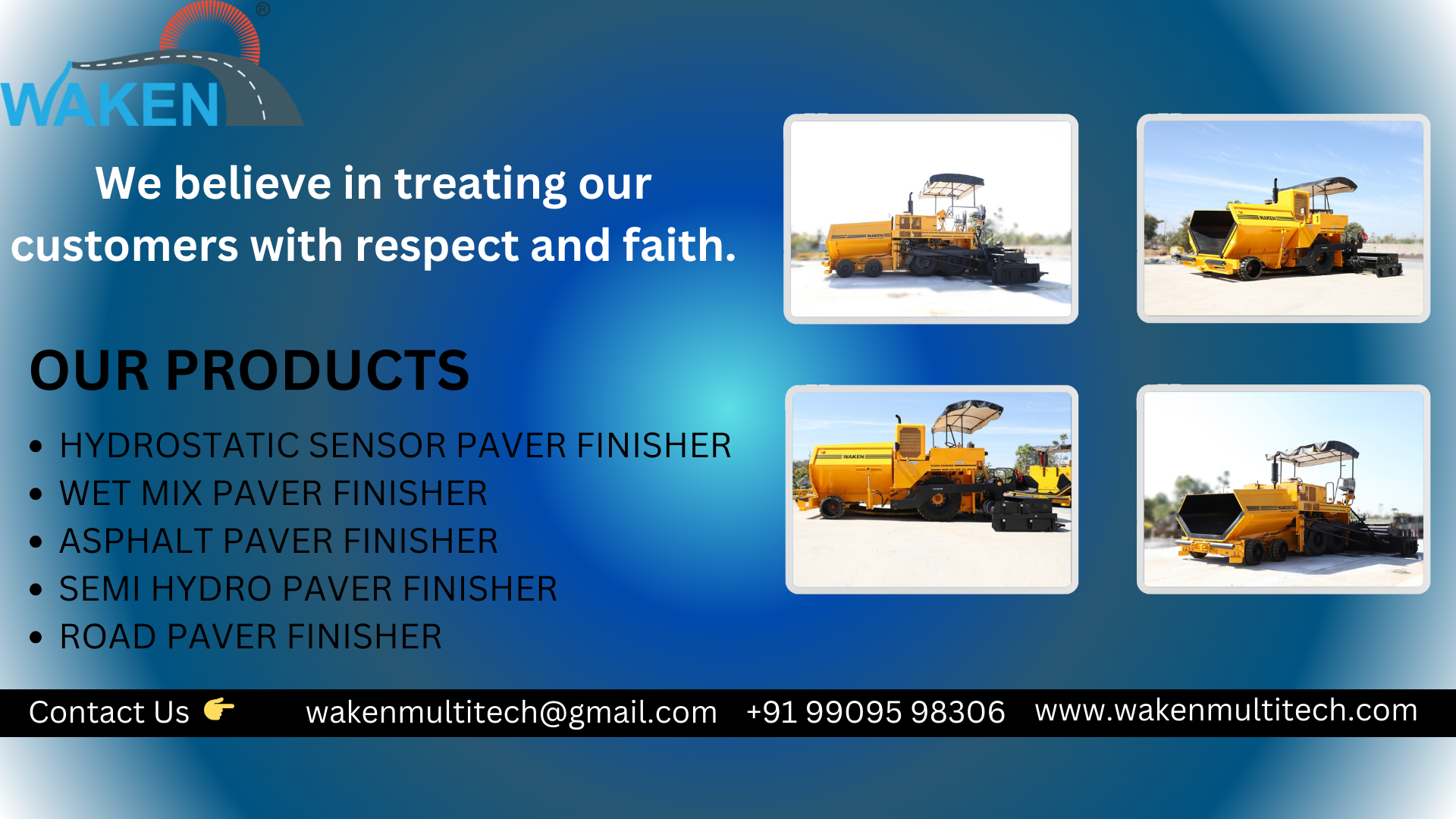Introduction to Hydrostatic Sensor Paver
A Hydrostatic Sensor Paver is an advanced asphalt paving machine that combines hydrostatic drive technology with grade and slope sensing for uniform mat thickness and excellent surface finish. Variable displacement pumps power conveyors, augers, and traction, enabling precise speed control and smooth direction changes on tight urban corridors. Indian contractors value stable feed, minimal jerk, and reduced operator fatigue during long pulls on highways and industrial roads. Heated screeds, vibration, and reliable controls deliver consistent texture ready for rolling. For specifications, compatible equipment, and support, explore our hydrostatic paving solutions. This balanced technology improves productivity, lowers rework, and supports quality compliance across resurfacing and new construction.
Working Principle and Process Flow of Hydrostatic Sensor Paver
Hot-mix asphalt is tipped into the hopper and metered by hydrostatically driven conveyors toward the augers. Augers spread material uniformly across the screed width, maintaining a consistent head of material. The heated screed floats on tow arms, levels, and pre-compacts to the target thickness while sensors assist grade and crossfall control. Hydrostatic traction provides stepless travel and smooth speed transitions, reducing segregation at truck exchanges. Operators tune paving speed, vibration, and screed temperature to suit mix and climate. Rollers follow for density. For planning plant capacities, rollers, and accessories, review our road construction machinery resources.
Types of Hydrostatic Sensor Paver
- Wheeled hydrostatic paver — rapid site transfers and higher travel speed; ideal for highways, bypasses, and urban corridors demanding productivity.
- Tracked hydrostatic paver — superior traction and flotation; recommended for uneven bases, rural stretches, and heavy mats requiring stable paving accuracy.
- Compact hydrostatic paver — narrow screed range; suited for service lanes, town streets, and projects with restricted access or frequent utilities.
- Sensor-assisted hydrostatic paver — integrates grade and slope automation to achieve tight tolerances on airports, expressways, and premium overlays consistently.
- High-capacity hydrostatic paver — enlarged hopper and feeders for continuous supply on big projects, enabling aggressive production targets with steady texture.
Key Features and Specifications of Hydrostatic Sensor Paver
- Hydraulic extendable screed 2.5–4.5 m, bolt-on extensions up to approximately 6.0 m.
- Dual independent conveyors and augers ensure uniform feed, reducing segregation across full width.
- Automatic grade and slope sensors maintain thickness and crossfall within specified tolerances reliably.
- Ergonomic operator station, canopy, LED work lights, and emergency interlocks enhance safety.
- Centralised lubrication, accessible wear parts, and onboard diagnostics minimise downtime and costs.
Applications of Hydrostatic Sensor Paver
- National and state highway overlays requiring long, continuous pulls with strict evenness criteria; hydrostatic drives keep speed steady, sensors maintain crossfall, and heated screeds produce uniform texture for improved ride quality and reduced rutting over years.
- Urban arterial rehabilitation near kerbs, medians, and manholes; precise steering and smooth transitions minimise rework, shorten lane closures, and enhance comfort while improving surface drainage and noise levels for daily commuters and public transport fleets reliably.
- Industrial estate and logistics yard pavements designed for heavy axle loads; stable feeders support thicker mats, consistent head-of-material, and clean tie-ins at joints, improving durability for forklifts, trailers, and mixed vehicles operating in demanding environments.
- Airport service roads and taxi support lanes demanding tight tolerances; sensor assistance maintains grade and crossfall, while hydrostatic traction ensures smooth pull, enabling safer towing operations and reliable drainage performance during intense monsoon conditions across regions.
Benefits of Using Hydrostatic Sensor Paver
- Higher return on investment from faster paving cycles, reduced mix wastage, and fewer corrective passes; hydrostatic smoothness improves mat uniformity, decreasing lifecycle maintenance budgets and extending pavement life under diverse traffic and climate conditions significantly.
- Superior surface quality and thickness control enhance ride comfort and safety; precise sensors and screed stability reduce undulations and edge waviness, supporting contractual IRI compliance and consistent outcomes across resurfacing, strengthening, and new construction projects reliably.
- Lower operator fatigue and training time due to stepless traction, intuitive controls, and assisted grade; better sightlines and automation shorten learning curves, reduce manual raking, and ensure repeatable productivity across shifts and varying supply conditions effectively.
- Scalable performance through modular screeds, bolt-on extensions, lighting packages, and telematics; supports fleet standardisation, safer operation, and future upgrades without frequent machine replacement, aligning capex with evolving standards and diversified municipal or highway tender requirements.
Top Manufacturers and Suppliers in India
India’s hydrostatic sensor paver market features domestic manufacturers and international brands represented through regional dealer networks. Buyers typically compare screed heating systems, conveyor and auger design, hopper capacity, engine efficiency, and sensor packages for grade or crossfall assistance. Common options include bolt-on screed extensions, lighting packages, centralised lubrication, and telematics for usage tracking. Vendors generally provide commissioning, operator training, and preventive maintenance plans backed by city-based parts warehouses. Contractors evaluate after-sales response times, warranty coverage, and documented project references before ordering. Lead times vary by configuration and season; some suppliers maintain demonstration or stock units. Financing via leasing and bank tie-ups is common, with buyers prioritising safety interlocks, reliability, and lifecycle costs across varied project profiles.
Maintenance and Safety Tips
- Inspect conveyors, augers, and hopper daily; remove hardened mix to ensure uniform feeding.
- Clean screed plates and tamper bars after shifts; lubricate per manufacturer schedule to reduce wear.
- Verify grade and slope sensor calibration weekly; check tow arm heights and screed crown.
- Train crews on PPE, hot-mix handling, safe communication protocols, and emergency stop procedures.
- Maintain critical spares, backup sensors, propane, and fuses; store covered to protect electronics.
FAQs – Hydrostatic Sensor Paver
Contact Details
Talk to our specialists today for tailored solutions and fast assistance.
